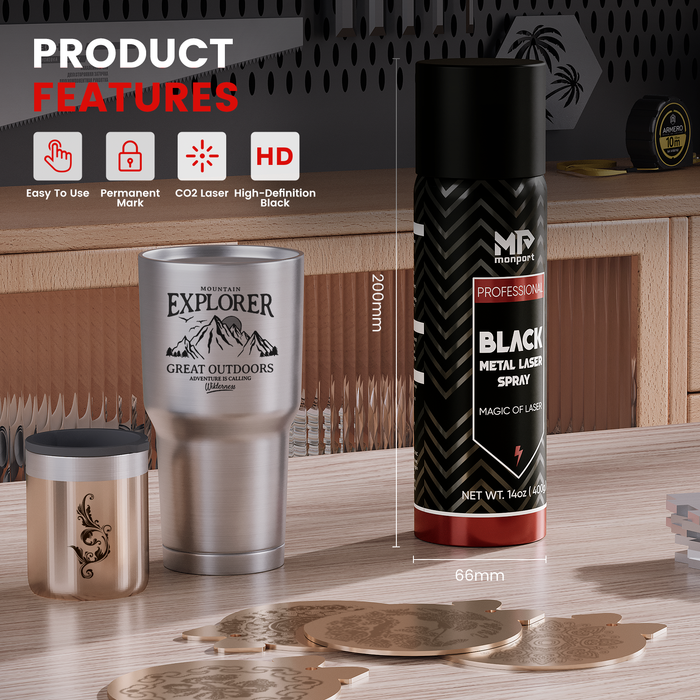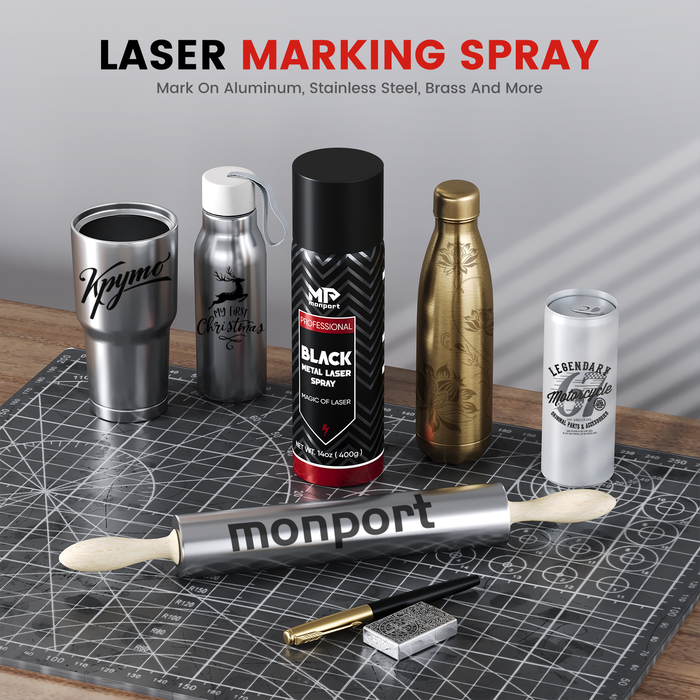Brass is a material that has been cherished for centuries due to its elegance, durability, and versatile use in various applications, making it an ideal choice for use with a cheap laser engraver, especially when paired with black laser marking spray to enhance the engraving contrast.Whether you're creating intricate jewelry, custom nameplates, or decorative pieces, laser etching brass and engraving brass offers a level of precision and detail that is hard to achieve through other methods. In this guide, we’ll explore the intricacies of laser etching brass, delve into how to engrave brass with perfection, and discuss why the Monport GPro 30W Split MOPA Fiber Laser Engraver & Marking Machine is an ideal tool for these tasks.
Introduction to Laser Etching Brass and How to Engrave Brass

Laser engraving yeti is a technique that uses a high-powered laser to remove a thin layer of material from the surface of the brass, creating detailed designs, logos, or text. This method is favored for its precision, ability to create fine details, and its non-contact nature, which ensures that the integrity of the brass is maintained. Whether you're working on small-scale projects like jewelry or large-scale applications like industrial nameplates, laser engraving yeti provides the accuracy and quality that professionals and hobbyists alike desire, especially when used with black laser marking spray for enhanced contrast and clarity.
Learning how to engrave brass using a cheap laser engraver involves understanding the nuances of laser settings, focus, and material preparation. Brass is a reflective material, which means it requires specific laser settings to achieve the best results without damaging the surface. The right laser engraver, like the Monport GPro 30W Split MOPA Fiber Laser Engraver, is essential in mastering this craft.
Benefits of Laser Etching Brass
Laser etching brass offers numerous benefits that make it the preferred method for engraving brass:
1. Precision and Detail
One of the standout features of laser etching brass is the precision it offers. The laser beam can be focused to a very small point, allowing for intricate designs and fine details that would be impossible to achieve with traditional engraving methods. This precision makes it ideal for creating complex patterns, detailed logos, and even photographic images on brass.
2. Durability and Longevity
Laser etching brass creates markings that are not only precise but also durable. The etched designs are resistant to wear and tear, making them perfect for items that will be handled frequently or exposed to the elements. This durability ensures that your engraved brass items will retain their quality and appearance over time.
3. Versatility in Design
The flexibility of laser etching brass allows for a wide range of design possibilities. Whether you want to create deep engravings or subtle surface etchings, the laser can be adjusted to achieve the desired effect. This versatility is especially beneficial for artists and designers who need to experiment with different styles and techniques.
4. Speed and Efficiency
Compared to traditional engraving methods, laser etching brass is much faster and more efficient. The laser engraver can complete complex designs in a fraction of the time it would take to do by hand, allowing for higher production rates without compromising on quality. This speed is crucial for businesses looking to meet tight deadlines or produce large quantities of engraved brass items.
5. Non-Contact Process
One of the advantages of using a laser for engraving is that it is a non-contact process. This means that the laser does not physically touch the brass, reducing the risk of scratches, dents, or other damage to the material. This non-contact nature also allows for more consistent results, as there is less chance of human error.
How to Engrave Brass: Step-by-Step Guide
To master how to engrave brass with a laser engraver, follow these steps:
-
Prepare the Brass Surface
Before starting the engraving process, ensure that the brass surface is clean and free of any dirt, oils, or residues. A clean surface is essential for achieving crisp, clear engravings. You can use a mild detergent and water to clean the brass, followed by a lint-free cloth to dry it. If you need to enhance contrast, use black laser marking spray on the brass surface before engraving.
-
Choose the Right Laser Settings
When learning how to engrave brass, selecting the correct laser settings is crucial. Brass is a reflective material, so you’ll need to adjust the laser’s power, speed, and frequency settings to achieve the best results. Generally, lower power settings with higher speeds work well for etching fine details, while higher power settings may be required for deeper engravings. You can also experiment with black laser marking spray for enhanced definition.
-
Focus the Laser
Proper focus is essential for achieving clean, precise engravings. The Monport GPro 30W Split MOPA Fiber Laser Engraver features a manual focus option that allows you to adjust the focal length based on the thickness of the brass. Take your time to ensure that the laser is correctly focused before starting the engraving process, and consider applying black laser marking spray for improved contrast.
-
Test the Settings
Before engraving the final design, it’s a good idea to test the settings on a scrap piece of brass. This will help you fine-tune the laser’s power and speed to ensure the best results. Adjust the settings as needed until you achieve the desired effect. Using black laser marking spray can help achieve better clarity during the test.
-
Start the Engraving Process
Once the settings are optimized, you can begin engraving your design onto the brass. Use the laser engraver’s software to upload your design and position it correctly on the brass surface. Start the engraving process and monitor it closely to ensure that everything is going smoothly, especially if you’ve used black laser marking spray for added definition.

Why the Monport GPro 30W Split MOPA Fiber Laser Engraver is Ideal for Brass
The cheap laser engraver Monport GPro 30W Split MOPA Fiber Laser Engraver & Marking Machine is an excellent choice for those looking to master laser engraving yeti. Here’s why:
1. High Precision and Accuracy
The Monport GPro 30W is designed for high-precision engraving, making it perfect for intricate designs on brass. The MOPA fiber laser allows for fine adjustments, ensuring that you can achieve the exact level of detail you need.
2. Adjustable Laser Settings
The ability to adjust the laser’s power, speed, and frequency settings makes the Monport GPro 30W incredibly versatile. Whether you’re working with thin brass sheets or thicker pieces, this machine can be tailored to meet the specific requirements of your project.
3. Durability and Reliability
Built with durability in mind, the Monport GPro 30W is a reliable tool that can handle high-volume production without compromising on quality. Its robust design ensures consistent performance, making it a valuable investment for professionals and hobbyists alike.
4. User-Friendly Interface
Despite its advanced features, the Monport GPro 30W is user-friendly and accessible to both beginners and experienced engravers. The intuitive interface and comprehensive support make it easy to learn how to engrave brass effectively.
5. Versatility in Material Handling
In addition to laser etching brass, the Monport GPro 30W can engrave a wide range of other materials, including stainless steel, aluminum, and even some plastics. This versatility makes it a valuable tool for any engraving business.
Key Takeaways
- Laser etching brass offers precision, durability, and versatility, making it an ideal method for engraving intricate designs on brass.
- Learning how to engrave brass requires understanding the correct laser settings, proper focus, and material preparation.
- The Monport GPro 30W Split MOPA Fiber Laser Engraver is the perfect tool for engraving brass, offering high precision, adjustable settings, and user-friendly features.
Q&A About Monport Laser Engravers
Q: Can the Monport GPro 30W engrave other metals besides brass?
A: Yes, the Monport GPro 30W is capable of engraving a wide range of metals, including stainless steel, aluminum, and copper. It is also suitable for engraving non-metal materials like plastics and ceramics.
Q: Is the Monport GPro 30W suitable for beginners?
A: Absolutely. The Monport GPro 30W is designed with user-friendliness in mind, making it accessible to both beginners and experienced users. The machine comes with comprehensive instructions and support to ensure a smooth learning curve.
Q: How does the MOPA fiber laser benefit brass engraving?
A: The MOPA fiber laser in the Monport GPro 30W allows for precise control over the engraving process, enabling users to achieve fine details and consistent results. This makes it particularly beneficial for intricate designs on brass.
Conclusion
Laser etching brass and engraving brass are art forms that combine precision, creativity, and technical skill. By mastering how to engrave brass using the right tools, you can create stunning, durable designs that stand the test of time. The cheap laser engraver yeti Monport GPro 30W Split MOPA Fiber Laser Engraver & Marking Machine offers the perfect combination of precision, versatility, and user-friendliness, making it an invaluable tool for anyone looking to excel in brass engraving. Whether you’re a seasoned professional or just starting out, investing in a high-quality cheap laser engraver yeti like the Monport GPro 30W will elevate your projects and ensure the best possible results.
Read More: Starting a Small Business with Engraved Brass Ornaments











